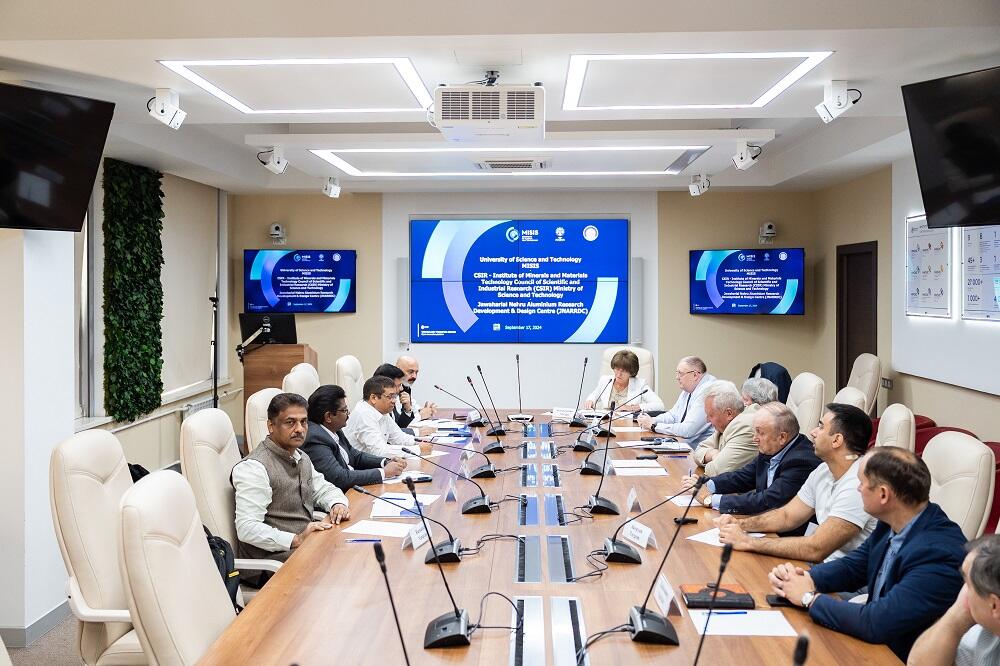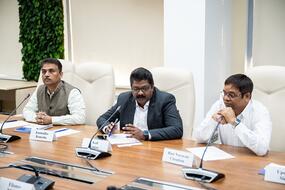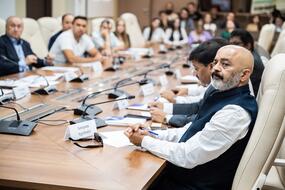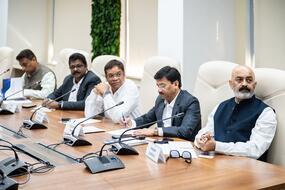A delegation from the Council of Scientific and Industrial Research (CSIR) and the Jawaharlal Nehru Aluminium Research Development and Design Centre (JNARDDC) visited NUST MISIS to discuss prospects for collaboration in the fields of mining and electrometallurgy. The guests were introduced to the University’s advanced developments and laboratory infrastructure. Both parties expressed interest in joint research projects.
During the meeting, NUST MISIS researchers presented promising industrial technologies to the guests. Torgom Akopyan, a senior researcher at the Department of Metal Processing at NUST MISIS, discussed the use of durable aluminum alloys in high-temperature industrial applications.
Vadim Tarasov, Head of the Department Engineering Management in Non-Ferrous Metal and Gold Production and Doctor of Technical Sciences, informed the delegation about technologies developed at MISIS University for the efficient extraction of non-ferrous and rare earth metals from ores and their recycling.
Associate Professor of the Department of Physical Materials Science Vladislav Zadorozhny delivered a presentation on “Storage, Extraction, and Generation of Hydrogen Using Magnesium-Based Alloys”, highlighting the use of composites in the energy sector.
Igor Savich, Professor at the Department of Geotechnology of Subsurface Development at NUST MISIS, discussed technologies for extracting essential minerals and metals.
Dr. Kali Sanjay, Chief Scientist and Head of the Hydro and Electrometallurgy Department at the CSIR Institute of Minerals and Materials Technology in New Delhi, noted that NUST MISIS is working on areas particularly interesting to India.
“In Russia, there is experience with resources that are not mined in India, such as nickel and cobalt, so we are interested in research that is promising for both sides. It is important for us to work together on new methods for extracting and processing critically important minerals, and I hope our meeting will be a starting point for long-term cooperation,” added Kali Sanjay.
Dr. Kannadka Ramesha, Director of the CSIR-Central Electrochemical Research Institute, remarked that there are many similar ideas between NUST MISIS scientists and his organization, expressing interest in future fruitful research.
The Council of Scientific and Industrial Research (CSIR) is an autonomous society headed by the Prime Minister of India, comprising 37 modern institutes and 3 separate units. It is one of the leading scientific and industrial research organizations in the world, covering nearly all areas of scientific and industrial work of national and international significance, such as aerospace, robotics, pharmaceuticals, etc. CSIR’s expertise and knowledge are embodied in its approximately 4,600 scientists, 8,000 technical staff, and 8,000 research students. The CSIR-Central Electrochemical Research Institute (CSIR-CECRI) is the largest research institution in electrochemistry in South Asia.
The Jawaharlal Nehru Aluminium Research Development and Design Centre (JNARDDC) is an autonomous body under the Central Government within the Ministry of Mines of India. Its goal is to implement available technologies for producing alumina and aluminum alloys both domestically and internationally, as well as to develop technical know-how.






